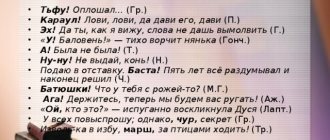The children got acquainted with “The Tale of Cheerful Sounds.”
“Once upon a time there were funny sounds. They knew how to sing songs. Their names were A, E, O, U, I, Y. And everyone together was called “vowel sounds.” The vowels had ringing voices and they sang like birds. One day they sang so joyfully that other sounds also wanted to sing.
- P, p, p, p,” the sound of P puffed. He puffed and puffed, but couldn’t sing the song. He cried and began to mourn: “Oh, how unsinging I am, I don’t have a voice, I can’t sing.”
- T, t, t, t,” the sound of T muffled. He tapped and tapped, but he couldn’t sing the song either. He cried and began to mourn: “Oh, how unsinging I am, I also have no voice, almost no one hears me.”
- K, k, k, k,” the sound of K groaned. He groaned and groaned, but could not sing the song. He cried and sunbathed, because he also really wanted to sing.
- Do not be sad, unsinging sounds! - said the vocal sound A, - We, vowel sounds, can help you. Only you must always stand next to us. Do you agree?
- We agree! We agree! - non-singing sounds screamed.
- That's good! For this we will call you all together “consonant sounds,” said the vowels.”
At this stage, acquaintance with two phonetic oppositions took place:
- first - by hardness - softness;
- then - by hardness - deafness.
The main means of control that determined the differentiation of hard and soft sounds was acoustic control.
Cards with a picture of an object and a diagram were given.
It was suggested to listen to what the vowel sounds in the words CAT and KIT sound like? Same or different?
Then it was found out what the first sounds in these words sound like?
Schemes of words using color symbols were laid out.
D.B. Elkonin proposed yellow to indicate hard consonants, and green to indicate soft consonants. Traditionally, when working with older preschoolers, blue is used to indicate hard consonants, and green for soft consonants.
In the country of Chrysostom, hard consonants wore blue suits - squares. They had a strict, firm character: they knocked strictly (t-t-t), puffed strictly (p-p-p), growled strictly (rr-r-r). Soft consonants loved green suits - squares, because they had a gentle, soft character. They knocked gently (t-t-t-t), puffed gently (p-p-p-p), and even growled gently (p-p-p-p).
The differentiation of voiceless and voiced consonant sounds occurred on the basis of tactile-vibrational control (i.e., based on the vibration of the vocal folds). An image of a bell was entered. Voiced consonants had bells, and voiceless consonants had no bells.
The inhabitants of Chrysostom helped in mastering the analysis and synthesis of words. They were friends, sang their songs, merging into one melody. By the end of this stage, children in the phonics analysis classes had five different types of counters.
Red chips were used to indicate vowel sounds, blue ones with a bell - for hard voiced consonants, blue without a bell - to indicate hard voiceless consonants, green with a bell - for soft voiced consonants, green without a bell - to indicate soft voiceless consonants. When conducting phonemic analysis, the diagram of the sound composition of the word was filled with colored chips.
Later, when they became acquainted with a new sound, the children independently put a suit on it and gave a description according to the reference diagram.
Next, work was carried out on transformation, changing the sound shell of a word through a system of vowels or consonant phonemes. The change in sound envelope through the system of vowels or consonants was carried out one at a time, for example,
*varnish – poppy – cancer; *varnish – face – bow.
At this stage, such sound combinations were proposed so that the child could operate with the semantics of a given word.
By acquiring knowledge about vowels and consonants, hard and soft sounds, children learned to conduct phonemic analysis of words of any complexity.
Here are some types of work on the development of complex forms of phonemic analysis:
- choose words with a certain number of sounds, for example, three sounds, four;
- select pictures whose names have a certain number of sounds (game “Pyramid”);
- choose words where the given sound would be in first, second, third place;
- name the words according to the proposed scheme;
- by transforming words by adding sound
- at the beginning of the word: mouth - mole, fur - laughter;
- at the end of the word: ox - wolf, floor - regiment;
- by transforming words, changing one sound of a word (chain of words) som – juice – soup – sokh – rubbish – cheese – son – son;
- rearranging the sounds: linden - saw, stick - paw.
The development of language analysis and synthesis was served by tasks like:
- from the first sounds in the names of every three pictures, create a one-syllable word;
- make up a word from the first sounds in the names of each of the four pictures, etc.
Dividing words into syllables also helped to more effectively master the sound analysis of a word. The work began with simple exercises.
In the game “Say the Word,” the speech therapist pronounced the first syllable, and the child pronounced the second. Then the children named the remembered words in full:
shi-na, ti-na, mi-na.
In the process of forming syllabic analysis and synthesis, the phasing of mental actions is taken into account. First, exercises were offered that relied on external, auxiliary means: clapping a word, tapping, walking. In the game “Walk the Word,” the speech therapist showed that when pronouncing different words, you can take a different number of steps (moon, car, plane). The children were asked to walk through the words they had invented. Having learned to correctly pronounce words of two or three syllables, not complicated by a combination of several consonants, games were used to master a more complex sound-syllable structure.
In the game “Choose a similar word,” the teacher named a word of two syllables, and the child selected a word of three syllables with the same ending. If the child found it difficult, he could choose a word using pictures selected for the game and laid out in front of him:
Christmas tree-broom, watering can-sticker, cannon-cracker.
Then, in the process of developing auditory analysis in speech, the ability to isolate a vowel sound in a word was formed. Graphic diagrams of words were used.
At the last stage the following games were used:
- "Confusion"
The teacher pronounced two syllables. It was necessary to change their places and name the resulting word.
Syllables: ka-mas, ta-pas, cha-Ka, ka-sum, na-sos, etc.
- "Come up with the beginning of a word"
The presenter said the end of the word. The child added the first syllable and named the whole word.
Syllables: - tire, - meta, - neta, - midor, - daughter, - losy, etc.
D.B. Elkonin emphasized: “Not only the acquisition of literacy, but also all subsequent acquisition of the language—grammar and associated spelling—depends on how the child discovers the sound reality of the language, the structure of the sound form of the word.”
After completing this work, children with level III OHP were examined again. The obtained data are presented in Appendix 3. The summarized data are presented in Table 3.
Data from a control examination of the speech of children with level III SLD
Table 3
| Phonematic perception | Articul. motor skills | Sound pronunciation | Syllabic structure of the word | |||||||||
| High | average | short | High | average | short | High | average | short | High | average | short | |
| First stage | 4 | 31 | 65 | 21 | 70 | 9 | 0 | 74 | 26 | 9 | 52 | 39 |
| Final examination | 39 | 57 | 4 | 100 | 0 | 0 | 31 | 61 | 8 | 17 | 78 | 5 |
Thus, it became clear that work on the development of phonemic perception influenced all components of children’s speech development, including the level of sound analysis and synthesis.
During the control examination, all children with level III SEN demonstrated a sufficient level of auditory perception.
When performing speech tests for the development of elementary phonemic analysis, 45% and 30% of children, respectively, accurately identified the sound in a word and selected words with a given sound; the rest required only minor variable assistance from an adult.
When performing tasks to isolate the first and last sounds in words, 80% and 90%, respectively, showed a sufficient level of development of this type of sensitivity, of which 30% had a high level.
The percentage of correct and independent determination of the place of sounds in the middle of a word was 22%, 61% with minimal help.
Analyzing a word, breaking it down into sounds, determining their number, and dividing the word into syllables became accessible to most children (92%).
This can be seen in more detail in Figure 3.
Figure 3
Comparative analysis of examination data of children with special needs at the ascertaining and control stages
As you can see, all indicators of the sensorimotor side of children’s speech, including those that describe the skills of sound analysis and synthesis, have improved significantly. Consequently, the hypothesis that speech therapy work on the formation of phonemic perception will also increase the level of development of sound analysis and synthesis skills in older preschoolers with level III SEN was confirmed.
Conclusion:
therefore, it is precisely the deficiencies in phonemic perception that underlie the difficulties in developing the skills of sound analysis and synthesis.
Phonemic analysis and synthesis in ontogenesis
A. N. Gvozdev believes that the function of the child’s auditory analyzer is formed early, much earlier than the speech motor analyzer. Already in the second week of life, the child, hearing the sounds of a voice, stops sucking; stops crying when people start talking to him. He early distinguishes the sounds of the human voice and responds to this stimulus, depending on the intonation, either with a smile or a cry.
From 6 months, by imitation, he pronounces individual phonemes, syllables, imitating tone, tempo, rhythm, melody and intonation.
By the age of 2, children begin to distinguish quasi-homonym words (paronyms). By this age, the formation of phonemic hearing ends, as evidenced by the child’s phonemic discrimination of all the sounds of his native language. He is able to distinguish words by sound that differ by one phoneme.
In the process of early speech development, expressive and impressive speech are closely related: on the one hand, speech development stimulates auditory perception, on the other hand, it clarifies one’s own pronunciation.
Formation of auditory control
L. E. Zhurova believes that children of primary preschool age are able to identify the first and last sound in a word, and children of middle preschool age can easily cope with this task. When analyzing the sound composition, the child begins to pronounce it in a special way with intonation highlighting the sound, which must then be named separately.
At the age of 3–7 years, the skill of auditory control over one’s pronunciation develops.
M.E. Khvattsev believes that phonemic hearing develops in unity with the articulation of sound.
With sufficient mental and speech development, phonemic perception is sufficiently formed already in preschool age. The process of phonemic analysis is a more complex function and is formed in children at later stages of speech development.
Phonemic analysis is a complex mental process. Readiness for sound analysis is acquired in the process of developing oral speech throughout preschool age.
Practical ideas about the sound composition of a language are formed on the basis of phonemic analysis and perception. Memory and attention play a significant role in this process.
A number of authors note that the formation of impressive speech is a complex process in which the following patterns are noted: from the perception and memorization of individual words and phrases to the formation of complex phonemic hearing and, on its basis, sound analysis, thanks to which a person masters written speech.
Stages of speech perception
N.H. Shvachkin divides the process of speech perception into 2 stages:
- prephonemic (from birth to 1 year);
- phonemic (after one year, respectively).
Prephonemic stage. The child does not distinguish between phonemes and the sound-syllable structure of a word. At this stage, the child’s sound complex has several meanings. In other words, up to 1 year of age, the semantic load is carried not by the phoneme, but by the intonation, rhythm, and general sound pattern of the word. Moreover, up to 6 months, intonation plays a leading role, and at the 6th month, rhythm takes on a semantic orientation.
Phonemic stage. “Phonological development occurs rapidly, constantly ahead of the child’s articulatory capabilities, which serves as the basis for improving pronunciation.” Until this moment, the child recognized words by sound pattern, and from that moment he began to distinguish phonemes. First, contrasting ones, then complex ones, and lastly distinguishes between acoustically similar ones.
conclusions
Thus, the following conclusions can be drawn:
- The function of the child’s auditory analyzer is formed early, much earlier than the speech motor analyzer.
- Phonemic hearing consists of the ability to generalize different sounds into separate groups, to combine sounds, taking as a basis some essential features and ignoring other, random features.
- The process of speech perception is divided into two stages: prephonemic and phonemic.
- N. Kh. Shvachkin identifies 12 phonemic series according to the order of formation in children.
- Of all types of analysis of speech flow (dividing sentences into words, words into syllables, syllables into sounds), the most difficult is the phonemic analysis of words.
- Practical ideas about the sound composition of a language are formed on the basis of phonemic analysis and perception. Memory and attention play a significant role in this process.




